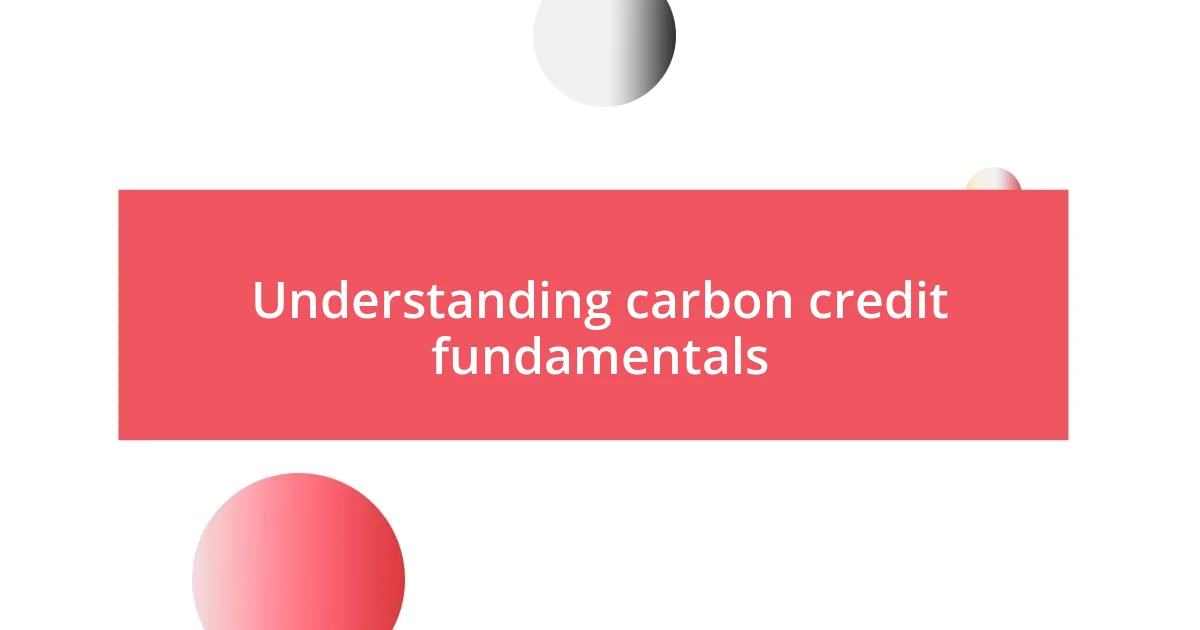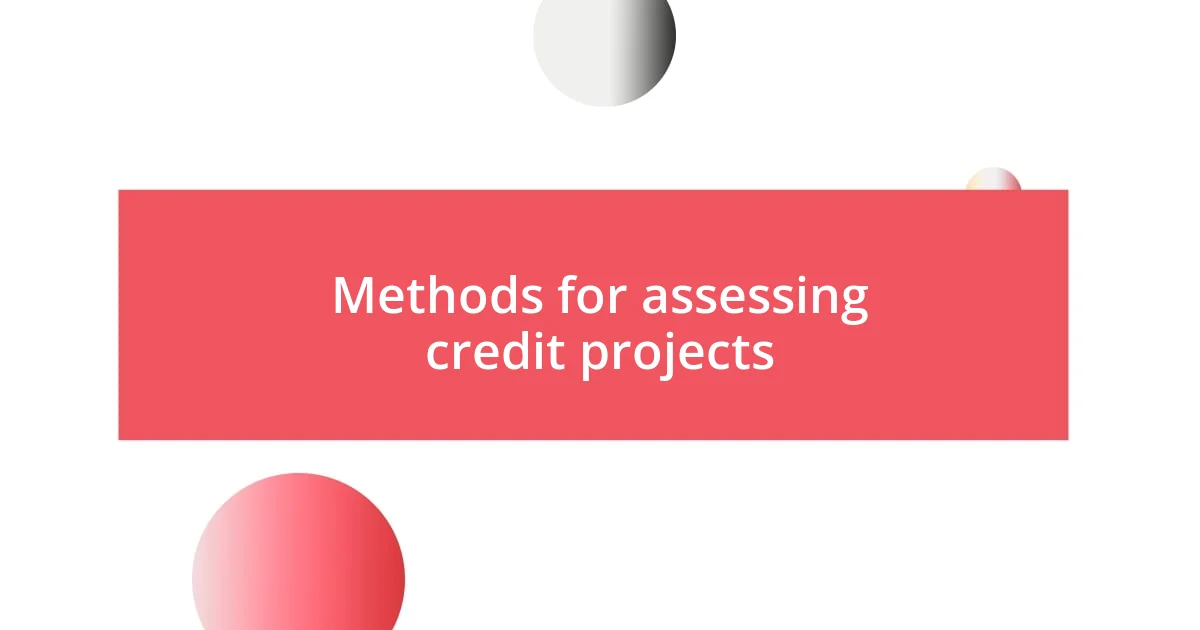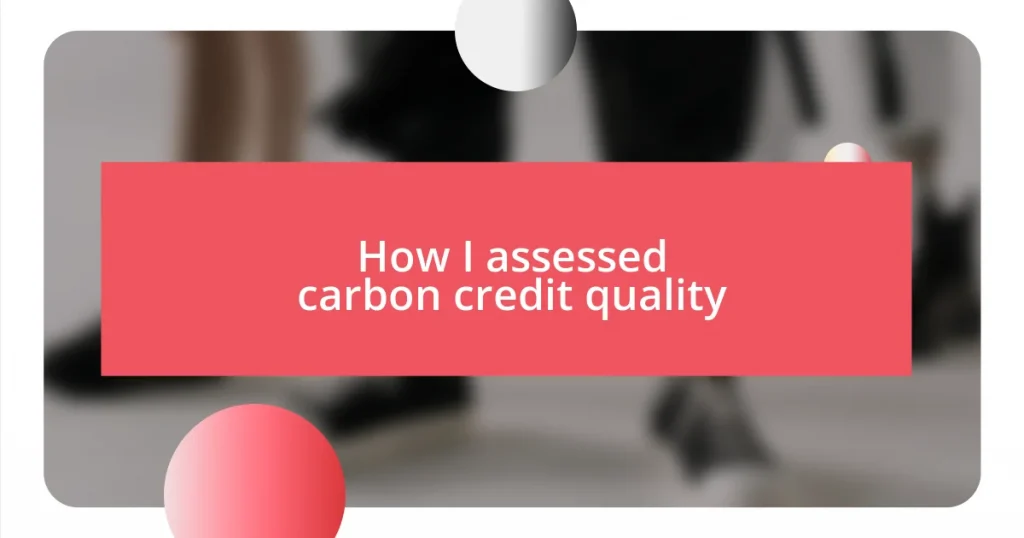Key takeaways:
- Carbon credits play a significant role in offsetting emissions, but their quality depends on criteria like credibility, additionality, and permanence.
- Thorough assessment methods, including baseline assessments and stakeholder engagement, are essential for verifying the effectiveness of carbon credit projects.
- Purchasing carbon credits should align with personal sustainability goals, diversified portfolios, and ongoing education to enhance impact and effectiveness.

Understanding carbon credit fundamentals
Carbon credits represent a tangible commitment to reducing greenhouse gas emissions, acting as a market-based approach to sustainability. When I first learned about these credits, I was struck by how they allow businesses and individuals to offset their carbon footprints. It’s fascinating to see how every credit corresponds to one metric ton of carbon dioxide equivalent (CO2e) that’s been prevented from entering the atmosphere—an impactful step for our planet.
As I delved deeper into the mechanics of carbon credits, I began to appreciate the intricate processes that define their quality. Not all credits are created equal; the best ones stem from high-quality projects that ensure real, measurable, and additional reductions in emissions. Have you ever considered what “additional” means? For me, it clicked when I realized that a project must deliver emissions reductions that wouldn’t have occurred without the carbon credit financing—like a deforestation project funded through carbon credit sales.
The verification process plays a crucial role in establishing trust in the carbon credit system. I remember attending a workshop where an expert emphasized the importance of third-party verification. It made me think: If we’re investing in credits to mitigate climate change, shouldn’t we know they’re making a difference? That’s why examining the integrity of carbon credit projects is essential; it gives us confidence that our efforts are genuinely helping to combat climate change.

Key criteria for evaluating credits
When evaluating carbon credits, I focus on several key criteria that help determine their overall quality. Firstly, the credibility of the project is paramount. I recall a time I scrutinized a specific reforestation initiative—a project that promised multiple benefits but fell short under close examination. It highlighted how critical it is to assess whether the project genuinely contributes to emission reductions, rather than just claiming it does.
Next, additionality is a fundamental concept. I once questioned why certain projects seemed to achieve their goals effortlessly. Upon further investigation, I learned that they often depended on external financing through carbon credits to carry out activities that wouldn’t have happened otherwise. This understanding clarified why additionality serves as a benchmark for evaluating the effectiveness of carbon credits.
Lastly, the permanence of emission reductions must be considered. I vividly remember discussing this at a sustainability conference where someone pointed out that projects could fail, leading to reversals in benefits. This notion stuck with me—it’s crucial to ensure that the positive impact of a project remains intact over time. I often find myself weighing these factors rigorously as they can significantly influence the overall value of carbon credits.
| Criteria | Description |
|---|---|
| Credibility | Refers to the trustworthiness and legitimacy of the project. |
| Additionality | Checks whether emissions reductions would have occurred without the project. |
| Permanence | Ensures that the benefits of the project are long-lasting and do not revert. |

Methods for assessing credit projects
To assess carbon credit projects effectively, I often rely on a combination of qualitative and quantitative methods. One particularly impactful approach I encountered was the use of baseline assessments. During a project visit, I saw how establishing a baseline allowed developers to track progress and substantiate claims of emission reductions. It was eye-opening to witness firsthand how data-driven insights can paint a clear picture of a project’s effectiveness.
Here are some methods I find valuable:
- Baseline Assessment: Evaluates what emissions would be without the project.
- Site Visits: Direct inspections provide a clear view of project operations and compliance.
- Stakeholder Interviews: Engaging with local communities offers insights that figures alone cannot capture.
- Data Analysis: Scrutinizing emissions data helps validate claims of success and longevity.
- Third-party Verification: Independent assessments foster credibility and transparency, crucial for building trust.
In my experience, data, though vital, often only tells part of the story. I remember a moment talking with project beneficiaries, who shared their personal transformations thanks to the project. Their stories brought the numbers to life and underscored the importance of connecting emotionally with the people behind the credits. This holistic approach not only enhances my understanding but deepens my commitment to supporting only quality projects.

Checking third-party verification standards
When it comes to checking third-party verification standards, I genuinely believe this step is crucial for ensuring the integrity of carbon credits. During one of my assessments, I encountered a project proudly showcasing its certifications, but I soon learned that the standards used for verification were outdated. It made me realize that I should have dug deeper into the specifics of their verification process; after all, it’s all about finding a reliable framework that aligns with the latest scientific methodologies.
I often reflect on a notable experience where I attended a workshop on verification standards. There, I engaged with industry experts who emphasized the importance of international standards like ISO 14064. What struck me was their argument that rigorous third-party verification ensures that emissions reductions are both credible and traceable. Trust is built on transparency, and knowing that an independent entity has reviewed a project gives me confidence in the carbon credits I choose to support.
Moreover, I’ve come to appreciate the role of reputable verifiers. Once, while analyzing a project, I discovered it had been reviewed by a well-known organization with a robust track record. This gave me pause for thought: how many other projects might benefit from being scrutinized by a similar authority? It’s a reminder that in the ever-evolving world of carbon credits, leaning on established verification standards is not just best practice; it’s essential to safeguarding environmental integrity.

Analyzing historical project performance
Analyzing the historical performance of carbon credit projects offers a lens through which we can gauge their effectiveness and long-term viability. In one instance, I took a close look at a reforestation initiative that had been running for several years. Their tracking system revealed a steady increase in carbon sequestration over time, reinforcing my belief that scrutinizing project history can illuminate trends that data alone might not convey. Isn’t it fascinating how patterns in performance can lead us to trust—or question—specific projects?
Moreover, what struck me during my analysis was the importance of understanding the context of each project. While reviewing an agroforestry program, I connected with project managers who shared challenges they faced in the early years. Their perseverance through obstacles, such as adverse weather conditions, led to improvements in their methods that ultimately boosted carbon credits over time. It made me wonder: how many other projects face similar hurdles but may not have the same level of resilience?
Reflecting on these historical narratives proves vital. When assessing performance, I find that understanding successes and setbacks not only shapes my investment decisions but also fosters a deeper connection to the work being done. I remember standing in a field with enthusiastic farmers, seeing firsthand the impact of sustainable practices on their land. Those moments brought the data to life, reminding me that behind every number, there’s a story waiting to be told.

Best practices for purchasing credits
One of the best practices I’ve adopted for purchasing carbon credits is developing a clear understanding of my own sustainability goals. For me, it all began with a conversation during a community meeting about reducing our carbon footprint. I realized that aligning my credit purchases with specific objectives not only enhances their impact but also creates a sense of accountability. What are my priorities? Is it protecting biodiversity, supporting renewable energy, or fostering community resilience? These questions guide my decisions and ensure that my credits contribute meaningfully to the cause I care about.
Additionally, I’ve found that diversifying my portfolio of carbon credits can help mitigate risks associated with single projects. While I was evaluating different credits, I once invested in a mix of forestry, renewable energy, and waste management projects. This blend not only provided varied avenues for carbon reduction but also gave me a deeper appreciation for different approaches to combating climate change. Wouldn’t it be fascinating to see how these diverse initiatives collectively contribute to our global goals? It’s this kind of strategic thinking that makes purchasing credits not just a transaction, but a conscious effort toward sustainability.
Another critical aspect I emphasize is the importance of continuous learning and staying informed. After attending a webinar on emerging trends in carbon markets, I discovered several innovative projects that caught my attention. Engaging with experts and fellow enthusiasts in these forums not only enhances my knowledge but also makes me feel like part of a larger movement. It drives home the point: the more informed I am, the more effectively I can support projects that resonate with my values. Have you considered how your expertise can evolve through ongoing education? I know it’s been a game-changer for me in making well-rounded, impactful purchasing decisions.















